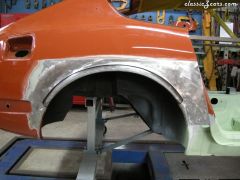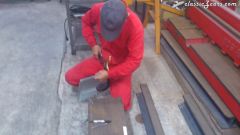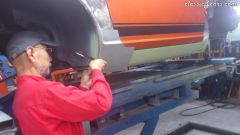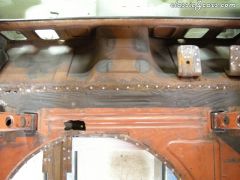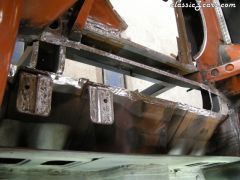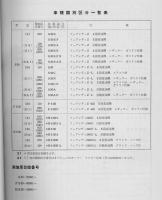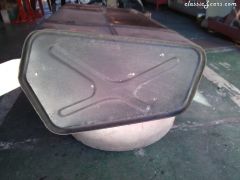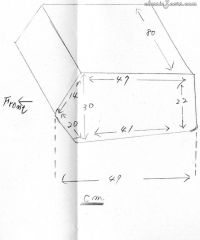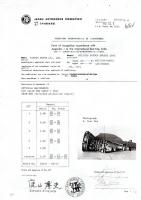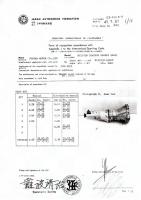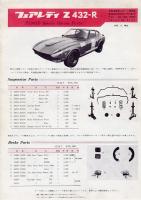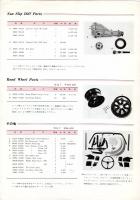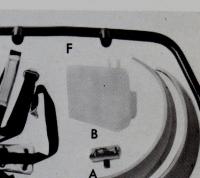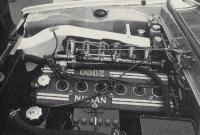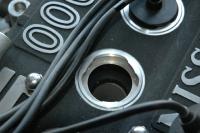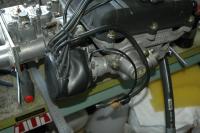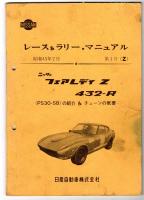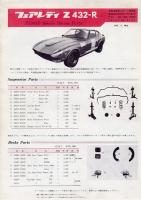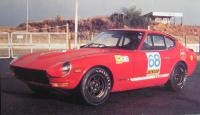Everything posted by HS30-H
-
Mystery Metal
Any "rally package" would have been installed by a private owner or shop, as Nissan never sold any "rally package" that included such parts and only made rally cars for its own factory use. They never sold such to the general public. It would be a logical place to put a Halda Tripmaster or other proprietary distance-measuring meters and a stopwatch setup, for "rally" use. However, it might also have been a mounting / blanking plate for a grab handle ( which I've seen before ). Unless there is other tell-tale evidence of rally / trials use, they may just have been the affectations and whims of a former owner.
-
Is this a factory jdm radio?
Looks like a late S31 extra cost option ( 1976/7/8 ): B9300-N4603 STEREO KIT - CASSETTE - W/AM-FM MPX HITACHI.
-
L-Series engine timeline
In that case, please clearly label it as such. If you leave it as it is, people will do what they always do, and think that the "American" market is the only story.
-
L-Series engine timeline
EuroDat, How are you going to address the fact that there was no simple, linear time-line style breakdown for the engines fitted in different models and in different markets? You're going to need to think about this again before you design your layout. I'm disappointed to see you ignoring the Japanese market models of a Japanese car ( you don't seem to have even thought of them...? ) but it's even more disappointing to see somebody from the Netherlands ignore the European market versions too ( look at your '260Z' data.... ). It's a big task you're taking on, and hats off to you for trying, but it's got to be RIGHT or there's no point. There are already more inaccurate data sources out there than you can shake a stick at, and we don't need any more poisoned wells. Sorry to be harsh, but I think it needs to be said.
-
L-Series engine timeline
Except that it completely ignores the Japanese market L20A and L20AE-engined models. Speechless.....
-
Let's show vintage racing pictures. I'll start.
Look again. The emblems say 'Fairlady 240Z'. Correct factory badging for L24-engined Fairlady 240Z, Fairlady 240Z-L or Fairlady 240ZG.
-
original blue engine paint colorcode?
Do you guys ever use the SEARCH function? We've discussed all this many times before. The original colour had its roots in the Austin-Nissan tie up of the 1950s. The colour is still listed on the 'British Standard' database as B.S. 18C39, with HMG ( Her Majesty's Government ) Glidden number GL31557, and Glidden number name 'Dolphin Blue'. I think a Netherlands-based paint supplier should be able to cross-reference those codes.
-
1970 240z head
You need to be more careful about how you write the transmission codes out. You meant to write FS5W71B and FS5W71C. F5W71B and F5W71C are something else entirely....
-
432R is beautiful; but
-
432R is beautiful; but
-
432R is beautiful; but
-
432R is beautiful; but
-
432R is beautiful; but
-
How rare is an original 5 speed manual 240z?
To be fair, historically the situation was probably pretty much the same outside the US too. However, we've spent lot of time on this forum over the years discussing this very topic and these very terms. It would be nice to think that some of that would have rubbed off, and that people would not be quite so incredulous to hear that an HLS30-prefixed 'Datsun 240Z' might have come from the factory with an FS5C71-A trans and 3.9:1 diff as standard equipment somewhere in the world ( "impossibly rare"....? ). After all, as yourself and 26th-Z have shown, it's all in the factory manuals and service bulletins..... On the subject of suffixes, spare a thought for the Japanese market. In October 1971, there were more prefixes and suffixes attached to the 'S30' series code than you could shake a stick at:
-
How rare is an original 5 speed manual 240z?
I don't want to sound rude, but this is pretty basic stuff we're talking about here.... The north American market 'Datsun 240Z' didn't have a 'U' in its VIN prefix, but it had the 'U' suffix in its factory model variant code. In Japan they called it the 'Katashiki'. For the 'U' suffixed models, there were extra sub-variants depending upon the sales destination. The ful codes were not affixed to the car, and are not to be confused with the full VIN number / body serial number / 'Shatai Bango'. The RHD export 'HS30U' models also didn't have that 'U' in their VIN / body numbers, but it was there in the 'Katashiki' and that's why Haynes - following the example of the factory workshop manuals - put it in their manuals. The 'HLS301' was the LHD export market 'Datsun 240Z' which was manufactured specifically for the mainland European market. It had the FS5C71-A 5-speed transmission as standard equipment ( as did the 'HS30U' ). It was only the north American market cars that didn't get a 5-speed trans as standard equipment. Having said all that, GeoJoe's car - if it's a north American market model - would almost certainly not have been equipped with a 5-speed trans when it left the factory.
-
How rare is an original 5 speed manual 240z?
The Haynes manual is correct*. You guys are just not understanding the differences between an HLS30U and an HLS301 ( or an HS30U ). *Shocking, but true in this case.....
-
432R is beautiful; but
-
432R is beautiful; but
-
all gear sets from FIA 3023
From the left: F4W71A ( fitted to HLS30 / S30-S from Oct. 1969 ) FS5C71A ( fitted to H(L)S30 / S30 / PS30 / PS30-SB from Oct. 1969 ) Then in the middle, the July 1971 amendment with the optional 'Direct-Drive' version of the 71A ( 1:1 fifth gear, 'Dogleg' / 'Low Back' shift pattern ), which was never available as showroom stock equipment on an S30-series Z, but certainly was available as a 'Sports Option' part before the end of 1970. Then on the right the January 1972 amendment with the F4W71B ( fitted to HLS30 / S30-S from October 1971 ) and FS5C71B ( H(L)S30 / S30-S / PS30 from October 1971? ) There were several optional gearsets available for the F5C71B ( 1:1 'Direct Drive' / Dogleg 5-speed ) and FS5C71B ( Overdrive 5-speed ). There are possibly some other pages of the 3023 with relevance to transmissions that might be produced to satisfy road vehicle licensing / legality. Maybe a better way to get what you need might be to identify what you need to establish, and then seek out the data to support it. There are several ways that might get you to where you need to be..... Alan T.
-
all gear sets from FIA 3023
-
Genuine PS30-SB 'Fairlady Z432-R' refresh story in Gallery
Chris, The explanation is that the Parts Catalog lists and illustrates the stock parts for the PZR, and the PZR didn't have the expansion tank as a stock part. The 'Race & Rally Manual' for the PZR ( which is sometimes called the 'Yellow Book' ) shows owners how to modify their PZR for competition use, using many parts from the Sports Options list but also from other models ( including the PGC10 Skyline GT-R ). Please see below a scan of the back page of the Sports Options booklet for the PZR, and a close-up of the 'Reservoir Tank'. This was actually used as a kind of sub-tank / swirl pot in the race prep of the car, holding an amount of fuel drawn from the tank and pumping that up to the carbs. It helped to avoid fuel starvation due to slosh in that 100 litre main tank. The part numbers are actually different in the 'Yellow Book' and the Sports Options list, and the illustration in the Sports Options list looks a little different to the stock vapour tank, and it may have been the case that both were used. But I think the vapour recovery tank you see on your cars was very similar ( although it had more hose connections ), and I've seen these vapour recovery tank used as a sub-tank in this way. Main reason is that it's a lovely purpose-built snug fit in that right inner quarter area, and is fuel safe. Alan T.
-
Genuine PS30-SB 'Fairlady Z432-R' refresh story in Gallery
Hi Kats, Yes, Nissan were using the metal plug cap retainers on the works PGC10 and KPGC10 Skyline GT-R race cars too. They are simpler than the version seen on the GRX V12 engine I think. Distributor cap cover was rubber, and primarily intended to keep out rain water. Actually, even though Victory 50 are selling the plug cap retainers, I believe they were reproduced by a good friend of Matsui san ( NP35 ). Cheers, Alan T.
-
Genuine PS30-SB 'Fairlady Z432-R' refresh story in Gallery
Nissan's first official works race Z was something of a star, as it was used for the covers of several 432-R related publications. This was the car that took part in the 'Zen Nihon Suzuka 300km' race at Suzuka Circuit on 18th January 1970, driven by SCCN works team driver Moto Kitano. Sadly, it was to be car's first and last race. Forced to spin to avoid another car blocking the track, Kitano was T-boned by a following car and was lucky to avoid serious injury. The car was a banana-shaped write-off. Pictured: Nissan 'Yellow Book' Race & Rally Manual for the 432-R, front page of the Nissan Sports Options parts list for the 432-R, and the 'no.68' works 432-R race car in the old Suzuka Circuit paddock before that fateful 18th January 1970 race. Alan T.
-
Genuine PS30-SB 'Fairlady Z432-R' refresh story in Gallery
EuroDat, Just to clarify: This thread is primarily about the PS30-SB 'Fairlady Z432-R. The PS30 Fairlady Z432 had the 'normal' Master Vac brake booster and pedal, whilst the PS30-SB Fairlady Z432-R was the one without the Master Vac brake booster, and had a brake pedal with a greater leverage ratio to suit.
-
Genuine PS30-SB 'Fairlady Z432-R' refresh story in Gallery
Hi Ron, I would have thought that anyone ordering a PZR new would have been buying into the whole ethos of the car as a 'spartan', lightweight driver's car. The lightweight body, plastic windows and cloth-covered, non-reclining FRP seats would have been a big part of that and I can only imagine him adding some 'essentials' like the heater/demister for example. I would imagine that he didn't have a choice over whether to go with the lightweight panels ( especially the rear quarters and the roof ) if the PZR-specific bodies were already half made, or if there were a few complete cars already built. Officially there wasn't even a colour choice ( all the cars sold to the general public were 918 orange ) and if a customer wanted a few more bells and whistles he might as well have paid a little bit more and plumped for the 'ordinary' 432 with its 'Deluxe' spec. In the C-236 parts list I can see: 78100-E7200 PANEL arse'Y - rear fender ( R.H. ) - PZR 78100-E8201 PANEL arse'Y - rear fender ( R.H. ) - PZR ( from C/# PS30-00402 ) 78101-E7200 PANEL arse'Y - rear fender ( L.H. ) - PZR 78101-E8201 PANEL arse'Y - rear fender ( L.H. ) - PZR Off the top of my head, I'm thinking that this marks the changeover from solid, unvented rear pillars to the vented rear pillars. If they are for the PZR then they should be the thinner gauge steel pressings, or at least the earliest type would be. As we know from their chassis numbers, the PZRs sold to the genral public were all 'early' cars ( with unvented pillars ) - so perhaps the later part numbers were more a theoretical fitment should a car be ordered at that time...? Interestingly, the works rally 240Zs that were made in the mid to late 1971 period - using much of the PZR's bodyshell pieces - used the solid, unvented PZR rear quarters, but had their pillar vent holes cut out by hand and the vented 'Z' pillar emblems attached ( to make them look more 'up to date' no doubt ). They retained the FRP tailgates complete with twin vents and all the venting paraphernalia inside them. So they ended up with vented quarteers and vented tailgates.





